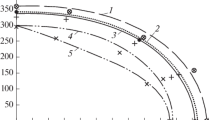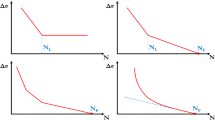Abstract
The goal of this study is to find the ‘safe’ long term behavior of elasto-plastic structural materials subjected to fluctuating load (shortly ‘fatigue limit’). The materials whose fatigue limits are checked are: (a) materials reinforced with unidirectional stiff fibers; (b) materials with dilute amount of inclusions; (c) materials with minute porosity. To reach this goal we employ two different shakedown theorems: Melan’s static shakedown theorem (1936) as the lower bound and Koiter’s kinematic shakedown theorem (1960) as the upper bound. The solutions to the lower and upper bounds for the prescribed stress amplitude, (Δσ th)l,b. and (Δσ tu.b.th , are expressed in a rigorous form with three parametric entities: (i) the volume fraction of the second phase in the base matrix phase, f, (ii) the quality of the ‘bond’ between the two phases ‘m’, (iii) the magnitude of the residual stress, ‘p’, pre-existed in the material. The deviation between the two bounds represents the ‘uncertainty’ in our knowledge of the actual safe/unsafe state, where the materials fail to withstand the alternating load. It is shown that in the considered three types of materials, at certain amount of residual stresses, the safe load amplitudes based on shakedown analysis are indeed higher than their corresponding elastic limits (at least by 5%, 10% and 25% respectively). The apparent advantage of using shakedown bounds to predict the safe/unsafe loading amplitude is that no prior information on the actual complex failure mechanisms is required and no empiricism is needed. However, empirical data which were found in the open literature are ‘falling’ satisfactorily between the computed dual bounds.
Similar content being viewed by others
References
Bower A.F. and Johnson K.L. (1989). The influence of strain hardening on cumulative plastic deformation in rolling and sliding line contact.Journal of the Mechanics and Physics Solids 37(4), 471–493.
Budianski, B. and Hutchinson, J.W. (1978). Analysis of closure in fatigue crack growth.Journal of Applied Mechanics and Transactions (ASME) 45, 267–276.
Dvorak, G.J. and Tarn, J.Q. (1975). Fatigue and shakedown in metal matrix composite. InFatigue of composite materials (ASTM, STP) 569, 145–168.
Goodier, J.N. (1933). Concentration of stress around spherical and cylindrical inclusions and flaws.Journal of Applied Mechanics APM-55-7, 39–44.
Gurson, A.L. (1977). Continuum theory of ductile rupture by void nucleation and growth. Part I - Yield criteria and flow rules for porous ductile media.Journal of Engineering Materials and Technology, (ASME Transaction) 114, 2–15.
Hadrboletz, A., Weiss, B. and Stickler, R. (1994). Fatigue Threshold of Metallic Materials — A Review.Handbook of Fatigue Crack Propagation in Metallic Structures. (Edited by Andrea Carpinteri), 847–882.
Huang, Y.J. and Stein, E. (1995). Prediction of the fatigue threshold for a cracked body using shakedown theory.Fatigue and Fracture of Engineering Materials ans Structures 18(3), 363–370.
Jansson, S. and Leckie, F.A. (1992). Mechanical behavior of a continuous fiber-reinforced aluminum matrix composite subjected to transverse and thermal loading.Journal of the Mechanics and Physics of Solids 40(3), 593–612.
Koiter, W.T. (1960). General theorems for elastic-plastic solids.Progress in Solid Mechanics 1,6, 203–313. (Edited by I.N. Sneddon and R. Hill), North-Holland, Amsterdam.
Melan, E. (1936). Theorie statisch unbestimmter Systeme aus idealplastischem Baustoff. Sitzungsbericht der Akademie der Wissenschaften, Wien, Abt. IIa, 145, 195–218.
Miller, K.J. (1989). The two thresholds of fatigue behavior.Fatigue and Fracture Engineering Materials and Structures 16(9), 931–939.
Muskhelishvili, N.I. (1963). Some basic problems of the mathematical theory of elasticity. P. Noordhoff Ltd. Groningen, The Netherlands.
Peles, S. (2001). Crack propagation models and shakedown bound in fatigue of metals. Ph.D. dissertation, Faculty of Mech., Eng., Technion, Haifa, Israel.
Polizzotto, C. (1993a). On the conditions to prevent plastic shakedown of structures: Part I — theory, Part II — the plastic shakedown limit load.Journal of Applied Mechanics (ASME Trans.) 60, 15–25.
Polizzotto, C. (1993b). A study on plastic shakedown of structures: Part I — basic properties, Part II — theorems.Journal of Applied Mechanics (ASME Trans.) 60, 318–330.
Ponter, A.R.S and Engelhardt, M. (2000). Shakedown limits for a general yield condition: Implementation and application for a Von Mises yield condition.European Journal of Mechanics and Solids 19, 423–425.
Ponter, A.R.S. and Karadeniz, S. (1985a). An extended shakedown theory for structures that suffer cyclic thermal loading, Part 1: Theory.Journal of Applied Mechanics (ASME Trans.) 52, 877–882.
Ponter, A.R.S. and Karadeniz, S. (1985b). An extended shakedown theory for structures that suffer cyclic thermal loading, Part 2: Applications.Journal of Applied Mechanics (ASME Trans.) 52, 883–889.
Ponter, A.R.S., Hearle, A.D. and Johnson, K.L. (1985). Application of the kinematic shakedown theorem to rolling and sliding point contacts.Journal of the Mechanics and Physics Solids 33, 339–362.
Rice, J.R. (1967). The mechanics of crack tip deformation and extension by fatigue. In: ‘Fatigue Crack Propagation’, ASTM, STP 415, 247–311.
Rice, J.R. and Tracey, D. (1969). On the ductile enlargement of voids in triaxial stress field.Journal of the Mechanics and Physics Solids 17, 201–217.
Shirizly, A., Tirosh, J. and Rubinski, L. (1998). Open die forging of porous materials.Materials Science and Engineering (A)249, 55–61.
Southwell, R.V. and Gough, H.J. (1926). On the concentration of stress in the neighborhood of a small spherical flaw and the propagation of fatigue fracture in ‘Statistically Isotropic’ materials. Phil. Mag. Jan, 71–96.
Suresh, S. (1999). ‘Fatigue of Materials’, Solid state science series, Cambridge Press.
Tirosh, J. (1998). The dual shakedown conditions for dilute fibrous composites.Journal of Mechancis and Physics of Solids 46, 167–185.
Tirosh, J. and Peles, S. (2001). Bounds on the fatigue threshold in Metals.Journal of the Mechanics and Physics of Solids 49, 1301–1322.
Tvergaard, V. (1981). Influence of voids on shear band instabilities under plain strain conditions.International Journal of Fracture 17, 389–407.
Tvergaard, V. (1982a). Ductile fracture by cavity nucleation between larger Voids.International Journal of Fracture 18, 237–251.
Tvergaard, V. (1982b). On localization in ductile materials containing spherical voids.Journal of the Mechanics and Physics Solids 30, 265–286.
Weitsman, Y. (1979). Residual thermal stresses due to cool-down of epoxy-resin composite.Journal of Applied Mechanics (Trans. ASME) 46, 563–567.
Author information
Authors and Affiliations
Rights and permissions
About this article
Cite this article
Tirosh, J., Peles, S. Lower and upper shakedown bounds for fatigue limit in two phase materials. Int J Fract 119, 65–81 (2003). https://doi.org/10.1023/A:1023941200689
Received:
Accepted:
Issue Date:
DOI: https://doi.org/10.1023/A:1023941200689




